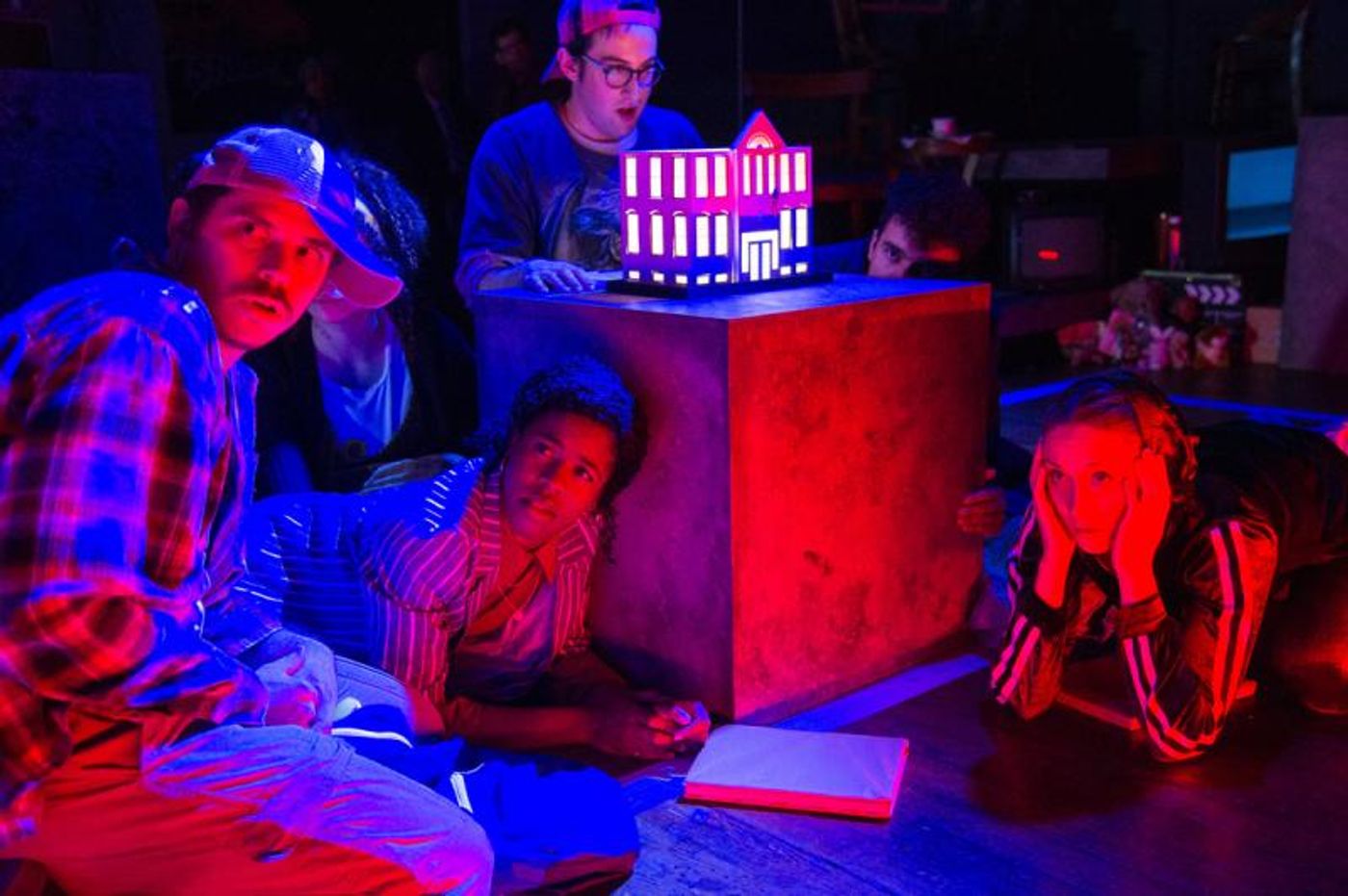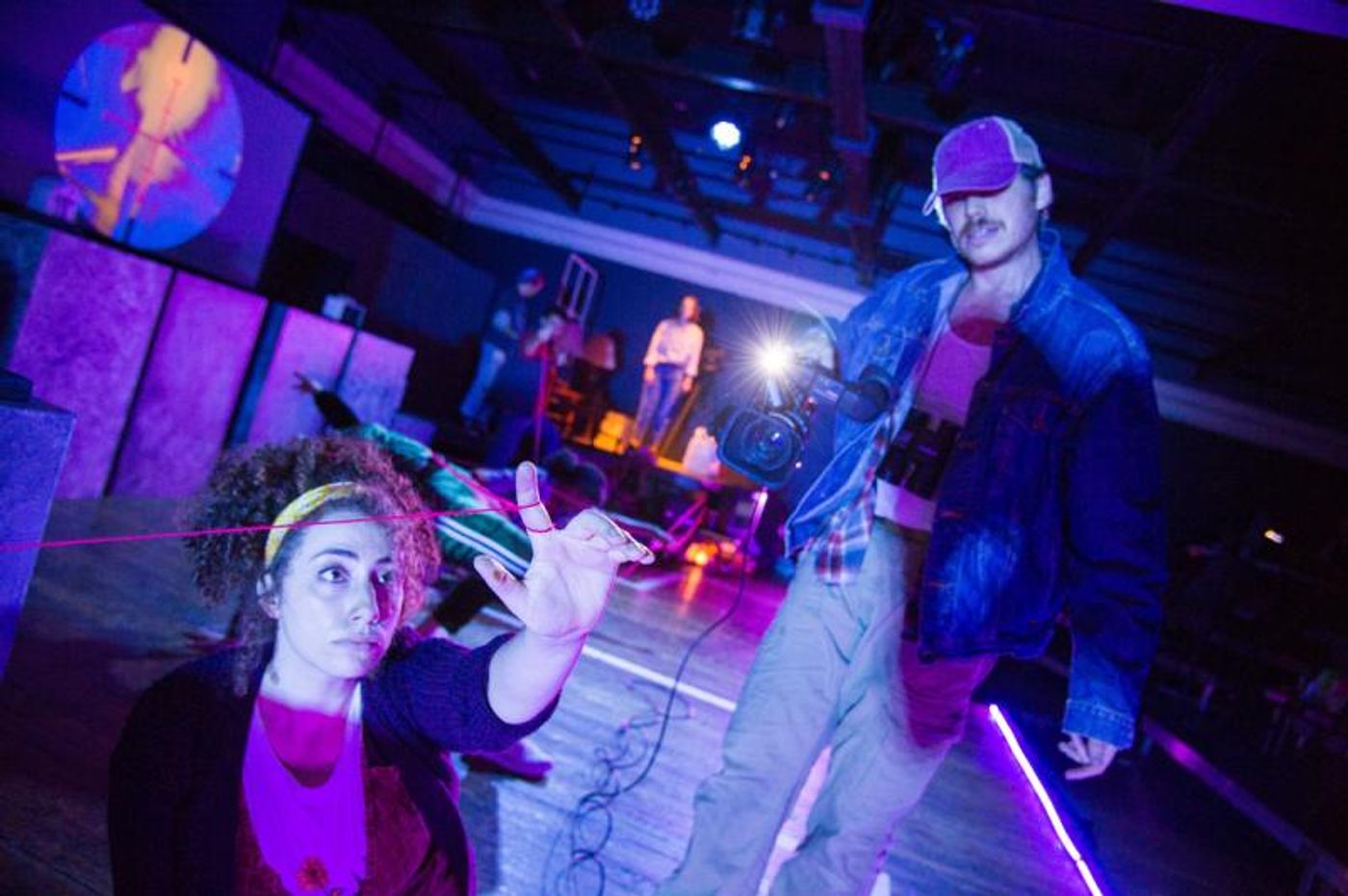Review: FOREST TREÁS at Pointless Theatre Company

Forest Treás (pronounced "Triage"), the season closer for Pointless Theatre Company, is a new work by Navid Azeez inspired by the October 2002 sniper attacks that looks at the effects of the media - specifically, omniscient cameras - on a community facing ongoing tragedy. The show is a sharp mixture of physical storytelling - Pointless' bread and butter, and never better than here - and live cameras and projections. It's a successful mixture, with many meaningful stage images. Forest Treás manages to mostly become a memorable and touching affair, though there are moments that are more successful than others.
Azeez's script is divided into two types of scenes. There are more traditional moments of dialogue, used to move the plot along, and a series of interviews between Roberta (Lee Gerstenhaber) and the residents of the fictional town of Forest Treás, a fictional, idyllic community somewhere in the DMV. The more standard dialogue scenes - mostly between Roberta and producers of a local TV show (Sara Herrera and Timothy Thompson) - are a bit underwritten. The early presence of David S. Kessler as Mr. Chylle, a local celebrity and retired TV host, brings a lot of warmth to those scenes, but he isn't in much of the show, and these scenes struggle to find much footing, ultimately restating themes of the show ("We've got to stick together" is a common refrain, stated literally or not) rather than digging deeper into its characters.
It's when Roberta turns the camera on the townspeople that things get interesting and where the shape of the show truly forms. Melissa Carter, Mason Catharini, Acacia Danielson, Nitsan Scharf, Eirin Stevenson and Eric Swartz are all wonderful, credited only as "Ensemble" (though their characters are named), each receiving a brief spotlight as they take us inside the lives of Forest Treás' community. The audience is treated to both marvelous stage pictures created by the performers - a long line of string laced over human limbs to create a map, the shape and journey of a van - and some unobtrusive camerawork by the ensemble. A particularly memorable example is a student describing the look on his teacher's face as she realizes what's happening during a code red; the camera scans over each performer's face, and we see up close a steely panic from each.
The stories told by Carter, Danielson and Catharini are all particularly memorable. and where Azeez really shines as a playwright. Kelly Colburn directs each of these sequences with a delicate touch, allowing the monologues, movement and technology to work in tandem. Carter's interview is the only one we see before the shootings; as a gas station owner and attendant whose life is defined fully and firmly by her life in Forest Treás, Carter's warm presence brings us into the moment. Danielson and Catharini's sequences work beautifully as deft insight into the many ways the shootings bring us into states of paranoia and distress; as (respectively) a runner who realizes she can be seen from anywhere and a man whose white van match the shooter's, they are both doing everything they can to retain their integrity. These scenes are also incredibly funny at times, briefly satirizing group panic yet always remaining truthful to how fear consumes us.

The team behind Forest Treás has worked hard to ensure that this subject matter is handled with grace, and they largely succeed. But there is one segment that brings everything to a halt, and it is a particularly troublesome one. One character, particularly affected by the shootings, begins to bemoan the lack of action taken by authorities, and implies his own desire to take care of the shooter. What ensues is a monologue with confusing intentions. Are we meant to hear the perspective of an all-but-self-proclaimed "good guy with a gun" and feel sympathy? The inclusion of this narrative - in a world where 170 individuals have been taken by gun violence in the US this year alone - is confusing and potentially triggering, and I found myself deeply troubled by the thematic muddiness of this character. Perhaps empathy is not the intention, but he's gone as soon as he's introduced, and it becomes difficult to understand why this moment is here at all.
Colburn brings her technical crew together mostly seamlessly. Dylan Uremovich's video & projections are as much a member of the ensemble as any actor, and Rachel Menyuk's movement direction is some of the most sublime storytelling to be seen in the show. Max Doolittle's lights (assisted by Hailey Laroe) make amazing use of the space at Dance Loft on 14, though some footlights in front of the front row are an unavoidable hazard; despite audience members being urged to watch their step, several individuals stumbled anyway. The spaciousness of the studio emphasizes the tech and Emily Lotz' set, but doesn't always do favors to the ensemble when it comes to volume, as many moments of dialogue are lost. A series of miniatures by Grace Guaniere are a beautiful addition, embodying the innocence of the town that is slowly taken away, and the props and costumes by Jeannette Christensen and Adrianna Watson are sparse and specific, intentionally doing lots with little to give room to the many cameras and TVs that permeate the set.
Forest Treás has moments of true power, but thematically it sometimes misses the mark; it's worth it for the former, and the latter is worth seeing and exploring more deeply. It's an ambitious project from a company that has always successfully melded its dynamic performances and technical prowess, and that's where Forest Treás shines.
Forest Treás runs 90 minutes without an intermission and plays through June 29 at Dance Loft on 14. Tickets are available here.
Reader Reviews
Videos

